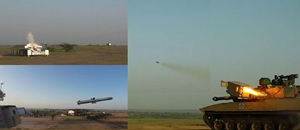08 December, 2025
Successful Test of 'Nag Mark-II' Anti-Tank Guided Missile from 'Zorawar' Light Tank
Sat 18 Oct, 2025
Context:
- The Defence Research and Development Organisation (DRDO) successfully tested the indigenously developed 'Nag Mark-II' Anti-Tank Guided Missile (ATGM) from the 'Zorawar' Light Tank on 17 October 2025.
Key Points:
- The test was conducted at the Pokhran Field Range in Rajasthan, where the missile’s striking capability, accuracy, top-attack mode, and mobility were thoroughly evaluated.
- Following successful trials, the complete weapon system is now ready to be inducted into the Indian Army.
'Zorawar' Light Tank (Zorawar Light Tank)
Development:
- The 'Zorawar' Light Tank was developed under 'Project Zorawar' to meet challenges in high-altitude areas along the Line of Actual Control (LAC) with China.
Features:
- Naming: The tank is named after the great Dogra military commander, General Zorawar Singh Kahluria.
- Weight and Mobility: Weighing around 25 tons, its light weight makes it ideal for airlifting by the Indian Air Force’s C-17 Globemaster III and Chinook helicopters, enabling rapid deployment in challenging and remote areas.
- Power-to-Weight Ratio: It is equipped with a high-horsepower (750–1000 hp) engine, providing a high power-to-weight ratio (approximately 30–40 hp/ton), ensuring better mobility in low-oxygen environments and rugged hilly terrain.
- Main Armament: The tank is armed with a 105 mm rifled gun from Belgium’s John Cockerill. The gun can fire both kinetic rounds and missiles, enhancing the tank’s versatile striking capability.
- Protection and Technology: Modular composite armor is provided, which can be augmented with additional armor if required. Advanced technologies include an Active Protection System (APS), laser warning receivers, and drone integration for enhanced situational awareness.
- Amphibious Capability: The tank is amphibious, enabling it to operate in rivers and marshy areas.
'Nag Mark-II' Anti-Tank Guided Missile (Nag Mark-II ATGM)
Features:
- Generation and Type: The Nag Mark-II is a third-generation, fully indigenous advanced ‘Fire-and-Forget’ anti-tank guided missile, which autonomously reaches its target once locked.
- Range: Its range is several times greater than the previous Nag Mark-I (around 4 km). According to reports, its estimated range is between 7 and 10 kilometers.
- Guidance System: The missile is equipped with an Imaging Infrared (IIR) seeker, which locks the target before launch and guides the missile in day/night and various weather conditions.
- Target Attack Profile: It uses a top-attack profile — climbing above the target and striking the weakest upper armor of a tank, increasing penetration capability.
- Warhead: The missile has a tandem High-Explosive Anti-Tank (HEAT) warhead. The first charge neutralizes the enemy’s Explosive Reactive Armor (ERA), and the second (main) charge penetrates the main armor to inflict damage.
Fire-and-Forget Missiles
- Fire-and-forget missiles utilize advanced guidance systems that do not require further operator intervention after launch, allowing safer and more efficient combat operations.
Examples in India:
- Nag MK-II: An advanced anti-tank guided missile with fire-and-forget capability.
- Astra: India’s air-to-air missile designed for beyond-visual-range (BVR) attacks, equipped with fire-and-forget capability.
- BrahMos: A supersonic cruise missile using fire-and-forget principles for precision strikes.


















